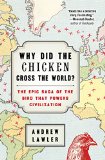Summary | Excerpt | Reviews | Beyond the Book | Readalikes | Genres & Themes | Author Bio
The Epic Saga of the Bird that Powers Civilization

Critics' Opinion:
Readers' Opinion:
First Published:
Dec 2014, 336 pages
Paperback:
Apr 2016, 336 pages
 Book Reviewed by:
Book Reviewed by:
Poornima Apte
Buy This Book
INTRODUCTION
Follow the chicken and find the world.
—Donna J. Haraway, When Species Meet
Add up the world's cats, dogs, pigs, and cows and there would still be more chickens. Toss in every rat on earth and the bird still dominates. The domestic fowl is the world's most ubiquitous bird and most common barnyard animal. More than 20 billion chickens live on our planet at any given moment, three for every human. The nearest avian competitor is the red-billed quelea, a little African finch numbering a mere 2 billion or so.
Only one country and one continent are fowl-free. Pope Francis I regularly dines on skinless breast bought in the markets of Rome since there is no room for a coop in the tiny state of Vatican City. In Antarctica, chickens are taboo. Grilled wings are a staple at the annual New Year's celebration at the South Pole's Amundsen-Scott Station, but the international treaty governing the southern continent forbids import of live or raw poultry to protect penguins from disease. Even so, most emperor penguin chicks have been exposed to common chicken viruses.
These exceptions prove the rule. From Siberia to the South Atlantic's South Sandwich Islands, the chicken is universal, and NASA has studied whether it could survive the trip to Mars. The bird that began in the thickets of South Asian jungles is now our single most important source of protein, and we are unlikely to leave the planet without it. As our cities and appetites grow, so does the population of, and our dependence on, the common fowl. "Both the jayhawk and the man eat chickens," wrote the American economist Henry George in 1879, "but the more jayhawks, the fewer chickens, while the more men, the more chickens."
Until recently I never thought to ask why this creature, out of fifteen thousand species of mammals and birds, emerged as our most important animal companion. My reporting took me to archaeology digs in the Middle East, Central Asia, and East Asia as I pursued the question of why and how our species abandoned the quiet hunter-gatherer life in favor of bustling cities, global empires, world wars, and social media. This mysterious and radical shift to urban life that began in the Middle East six millennia ago continues to transform the earth. Only in the past decade, for the first time in history, have more people lived in cities than the country.
When I heard that excavators working on an Arabian beach had evidence that Indian traders had mastered the monsoon to sail across the open ocean more than four thousand years ago, I pitched the story to a magazine. These adventurous Bronze Age sailors inaugurated international trade and helped spark the first global economy, carrying Himalayan timber and Afghan lapis lazuli to the great Mesopotamian cities as Egyptian masons put the finishing touches on the Giza pyramids. In my pitch, I mentioned to the editor that along with remains of ancient Indian trade goods, archaeologists had uncovered a chicken bone that might mark the bird's arrival in the West.
"That's interesting," the editor said. "Follow the bird. Where did it come from? Why do we eat so much of it? What is a chicken, anyway?" I agreed, reluctantly, and a few weeks later I arrived in a seaside Omani village as the Italian archaeology team working at the beach site was returning from an afternoon swim in the Arabian Sea. The chicken bone? "Oh," said the dig director, toweling his damp locks. "We think it was misidentified. It probably came from one of our workmen's lunches."
Since chickens didn't pull Babylonian war chariots or carry silks from China, archaeologists and historians have not given the bird much thought, and anthropologists prefer watching people hunt boar than feed fowl. Poultry scientists are fixated on converting grain to meat as efficiently as possible, not in tracing the bird's spread around the world. Even scientists who appreciate the importance of animals in the making of human societies tend to overlook the fowl. Jared Diamond, author of the bestseller Guns, Germs, and Steel, relegates the chicken to a category of "small domestic mammals and domestic birds and insects" that are useful but not worthy of the attention due, say, the ox.
Excerpted from Why Did the Chicken Cross the World? by Andrew Lawler. Copyright © 2014 by Andrew Lawler. Excerpted by permission of Atria Books. All rights reserved. No part of this excerpt may be reproduced or reprinted without permission in writing from the publisher.





The Funeral Cryer by Wenyan Lu
Debut novelist Wenyan Lu brings us this witty yet profound story about one woman's midlife reawakening in contemporary rural China.
Your guide toexceptional books
BookBrowse seeks out and recommends the best in contemporary fiction and nonfiction—books that not only engage and entertain but also deepen our understanding of ourselves and the world around us.